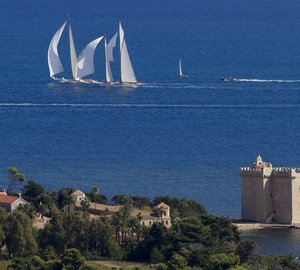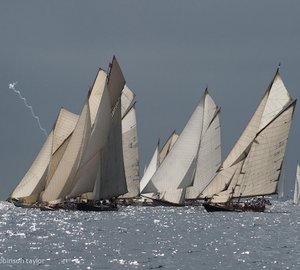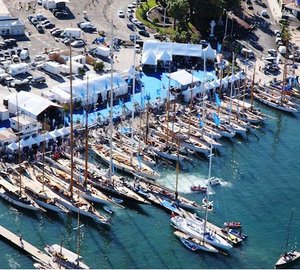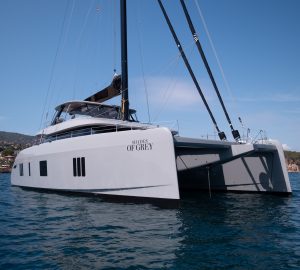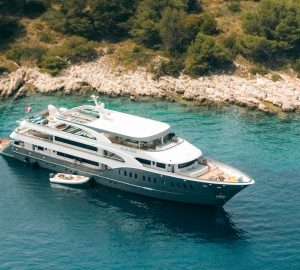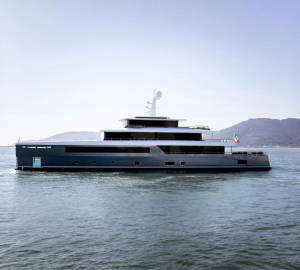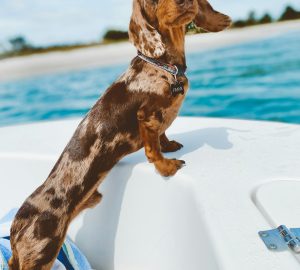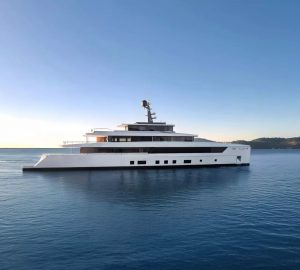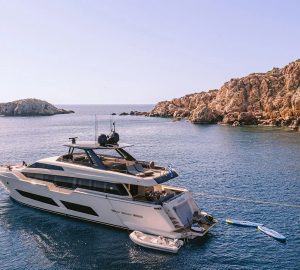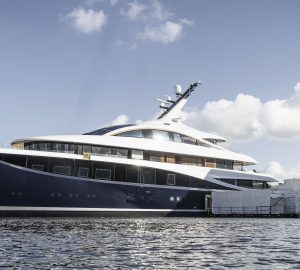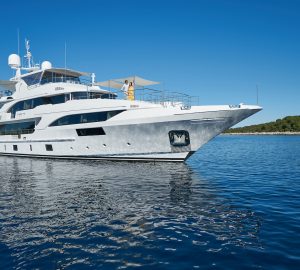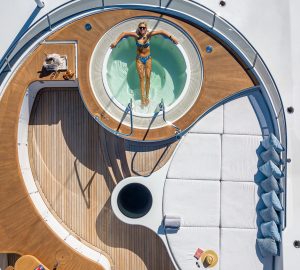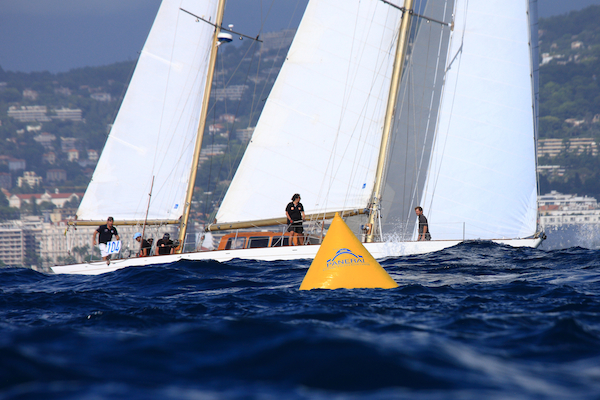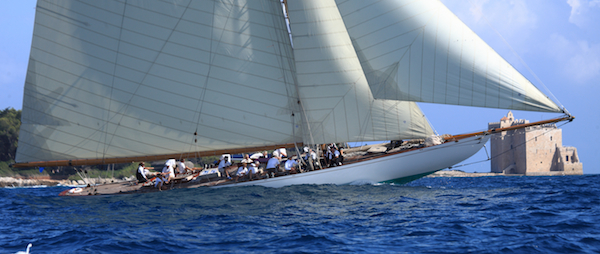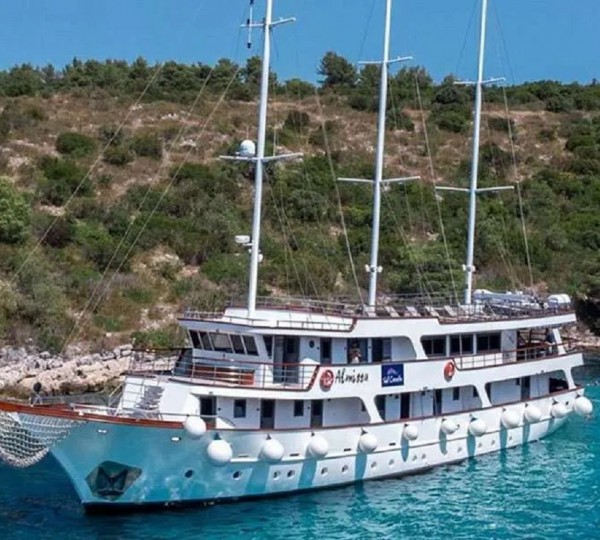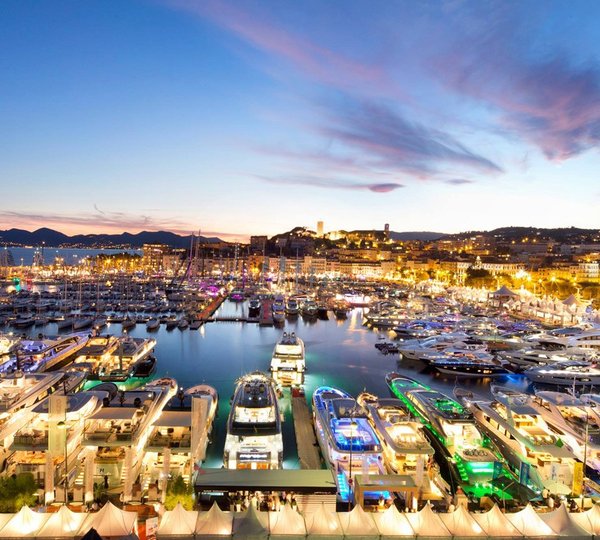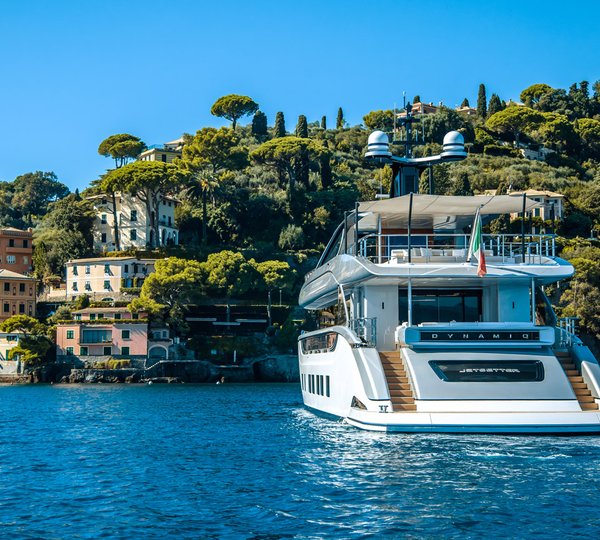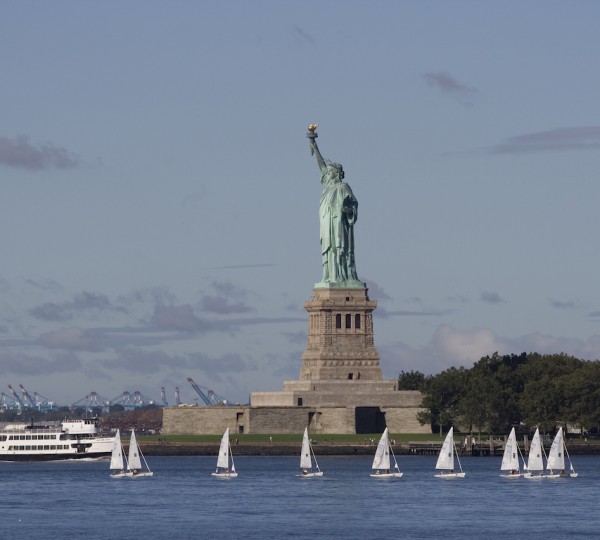The first day of the Régates Royales – Trophée Panerai saw almost perfect weather conditions, featuring good easterly/southeasterly breeze between 10 and 12 knots, smooth water and clear skies. The classic sailing yachts were able to race for the first points over a coastal course in the Bay of La Napoule. The 44 Dragons on the other hand completed to races.
Once more, the weather took central stage in Cannes during the morning hours, with huge, grey and menacing clouds hovering over the city and the race village. But, as it happened yesterday, a heavy shower gave way to a bright sun, blue skies and a variable wind that took some time to set in onto the race course. The Race Committee thus opted for a rectangular coastal course with the first mark just off the Lérins Islands, a downwind tack to Théoule, a long reaching to Mandelieu to finish upwind close to the marina entrance.
Classic J class charter yacht Shamrock V gets the first one
Eight miles to cover, all sails up, a magnificent show: the big J Class designed by Charles E. Nicholson opened the party for the hundred boats participating to the 34th edition of the Régates Royales-Trophée in a light easterly/south-easterly of ten to twelve knots. Sailing yacht Shamrock V finished in a bit more than 1 hour and twenty minutes, before Teewa 5 and the Tofinou 9.50 Speedbird both competing in the Spirit of Tradition division… But on corrected time it was the brand new Dilong (a Dragon hull equipped with a gaff rig) owned by Jacques Fauroux, Catleya to get the top spot .
Leonore yacht, the Q-Class formerly Cotton Blossom II, leads in the Marconi over 15 metres class followed by two Olin Stephens’ designed yachts, Skylark et Manitou, while sailing yacht Mariquita won among the Big Boats crossing the line a mere two minutes after the gigantic J Class sailing yacht Cambria… Cholita finished in first with an almost 15 minutes lead on her adversaries, the marconi less than 15 metres long class. The fight was closer among the Vintage yachts where White Dolphin won, followed by Italian Navy’s yacht Stella Polare. Sailing Yacht Avel confirmed his leading role among the Gaffs, despite Kelpie‘s and Nan of Fife’s brilliant performance.
A Cloud over the Annapurna
The 43 Dragons finally found the right conditions, albeit quite tricky for tacticians, to finish two windward/leeward races on the Golfe Juan bay. With the Iles de Lérins shadow and a southerly breeze of around six to eight knots all the crews opted for the left hand side of the course. If the first race had to be abandoned because the wind completely died away, the second race was won by Russian Anatoly Loginov (Annapurna) followed by his countryman Vassily Senatorov (I feel Good), while the second race went to one of the few female skippers in the fleet, UK’s Gavia Wilkinson-Cox (Jerboa) followed by ever-consistent Danish crew led by Soren Pehrsson (Blue Lady) and the reigning champion Guiseppe Duca (Cloud) from Italy. After three races the overall scoreboard is led by the Danish at 12 points, the Italian with 13 points and the Russian at 19 because of a not so brilliant second race of the day. In fourth Germany’s Helmut Schmidt at 20 points.
Tomorrow’s racing is expected to be tricky as the weather forecast speaks of heavy rainstorms and, as a consequence, very variable and shifty airs.
One date, one class
It’s 1904, the New York Yacht Club together with designer Nathanaël Herreshoff, decide to update the so called “Seawanhaka” rating rule that is twenty years old and replace it with the Universal Rule. The previous rule, as a matter of facts, did not take into account displacement or overhang that had become the norm and at times even excessive. Sailing Yacht Reliance, the most extreme of all the America’s cuppers and winner of the “Auld Mug” the previous year was 27,37 metres long bit her overall length amounted to no less than 43,79 metres, that is to say 6,70 aft and 7,92 forward!
The new rule defined a rating (R) taking into account the hull length (L) multiplied by the square root of the sail area (S) and by a fixed 0,182 coefficient, the result divided by the displacement cubic root. The hull length had to be balanced with the max beam, in order to reduce overhangs. The Universal Rule also gave origin to another ten classes, including the famous “J Class” that would compete in the America’s Cup from 1930 to 1937 (Entreprise vs sailing yacht Shamrock V in 1930, Rainbow vs Endeavour in 1934 and Ranger vs Endeavour II in 1937).
Among the newcomers to the Régates Royales-Trophée Panerai, is the Q-Class Jour de Fête designed by Frank Paine in 1930 competing against famous Cotton Blossom II the totally restored in 2003 by AC legend Dennis Conner and that is now owned by Mark Faulkner and went back to her original name yacht Leonore. This latter was designed by Norwegian Johan Anker built by Anker & Jensen near Oslo in 1925, while Jour de Fête is the sixteenth Q-Class, launched in 1930 under the name of Falcon II.
Sixty-seven Q-Class boats have been built between 1904 and 1938 like Dorothy Q (Q-2) and Eleanor (Q-3) by Francis Herreshoff in 1907, More Joy (designed by Francis Herreshoff in 1909), Virginia (W. Gardner, 1913), Grayling (Francis Herreshoff, 1923). Yet as the class was fast losing its appeal among North American owners so the Corinthian Yacht Club in Marblehead tries to re-style the Q-Class by increasing the length and reducing the sail area by 10% by introducing a Marconi rig.
These new rules pushed owners to start building again and a series of boats follow: Cotton Blossom II yacht (designed by Johan Anker and built by Anker & Jensen in 1925), Rascal (J.G. Alden built by Hodgon Bros. in 1925),Hornet (Frank Paine built by Lawley in 1926), Taygeta (J.G. Alden built by Lawley in 1926), Nor’easter V (Q-10, designed by Francis Herreshoff and buikt by Lawley in 1928), Robin and Cara Mia (Q-11 and Q-12, Franck Paine built by Lawley in 1928), Hope (Q-13, J.G. Alden built by Hodgon Bros. in 1929), Questa (Q-14, Francis Herreshoff, built by Lawley in 1929), Falcon II later named Hayday, and Jour de Fête (Q-16, Frank Paine and Lawley 1930), Stormy Petrel (designed by F.C. Brewer and built by South Coast Boat in 1937) and finally Tantalus the seems to be the last Q-Class to be created (design N.S. Potter built by Fellows & Stewart in 1938)…
One boat a day…
She’s debuting at the Régates Royales-Trophée Panerai 2012. Skylark is an Olin Stephens’s design dating back to 1937, built in the same year John F. Kennedy launched sailing yacht Manitou, also known as “the floating White House” that he owned until 1955. Skylark, tough, is a 53 footer (16,20 metres), 12 feet wide (3,70 metres) while the US President’s yawl measured 62 feet (18,50 metres). Built by shipyard Pendleton Yard in Maine, the boat is drawing number 146 by Sparkman & Stephens and was inspired by sailing yacht Stormy Wheather (1934 – drawing number 27) and Manitou yacht (1936 – number 99) that opened the way to the following series of fast cruising yawls signed by the renowned American architects like Comet (1940 – design number 522) or Argyll (1948 – number 628). Owned by Tara Getty, Skylark displacement is 20,741 kg, her sail area is 184m2 and in Cammes she will be battling against her “compatriots” Manitou et Argyll…

